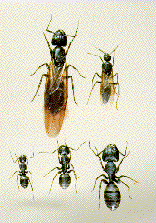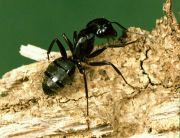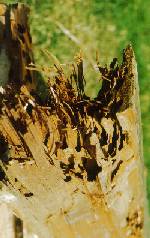| LIFE CYCLE INFORMATION |
|
Carpenter Ant Hymenoptera: Formicidae, Camponotus spp. SIZE: Large - from 1/4 inch (6.4mm) for a worker up to 3/4 inch (19.1mm) for a queen COLOR: Black, or sometimes red and black DESCRIPTION: Carpenter ants are active indoors during many months of the year, usually during the spring and summer. When ants are active in the house during late winter/early spring (February/March), the infestation (nest) is probably within the household. When carpenter ants are first seen in the spring and summer (May/June), then the nest is likely outdoors and the ants are simply coming in for food. The natural food of the ants consists of honeydew from aphids, other insects, and plant juices, but they will readily forage for water and food scraps within the house. HABITAT: Under natural conditions, carpenter ants nest in live and dead trees and in rotting logs and stumps. However, they will also construct their nests in houses, telephone poles, and other man-made wooden structures. Nests are begun in deteriorating wood which has been exposed to moisture. Often, the colony will extend its nest to adjacent, sound wood. Nests are commonly found in porch pillars and roofs, window sills, and wood in contact with soil. LIFE CYCLE: The colonies of carpenter ants are often long lived. Each colony is founded by a single fertilized queen. She establishes a nesting site in a cavity in wood. She then rears her first brood of workers, feeding them salivary secretions. She does not leave the nest nor feed herself throughout this period. The workers which are reared first assume the task of gathering food with which to feed the younger larvae. As the food supply becomes more constant, the colony population grows very rapidly. A colony does not reach maturity and become capable of producing young queens and males until it contains 2,000 or more workers. It may take a colony from three to six years or more to reach this stage. Each year thereafter, the colony will continue to produce winged queens and males, which leave their nest and conduct mating flights from May through July. TYPE OF DAMAGE: Carpenter ants rarely cause
structural damage to buildings, although they can cause significant
damage over a period of years because nests are so long lived. Some
recent evidence indicates that they can also cause extensive damage to
foam insulation. CONTROL: Control of carpenter ant infestations requires that the nest be found. Once this is done, the infested wood can be removed or treated chemically, and causes of moisture damage to the wood can be corrected. The best procedure is to inspect all possible locations-and to select these locations on the basis of potential water exposure. Once the nest is located, control can be achieved by the use of an aerosol insecticide labeled for the purpose. INTERESTING FACTS: Ants of the genus Camponotus are known as carpenter ants because they house their colonies in galleries they excavate in wood. Carpenter ants do not eat the wood they remove during their nest-building activities, but deposit it outside entrances to the colony in small piles. The wood is used solely as a nesting site. The galleries of carpenter ants are kept smooth and clean, and are not lined with moist soil as termite galleries are. RETURN TO TOP |


